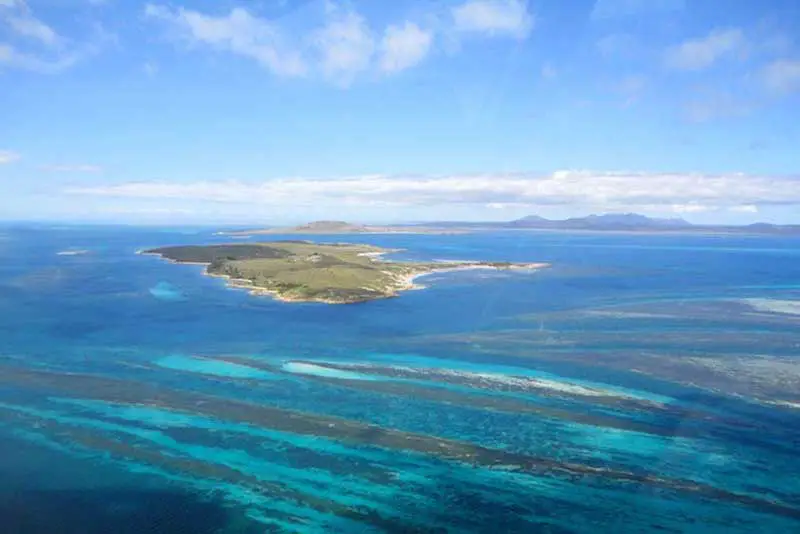






 Contact
Contact

Bass Strait Ferries
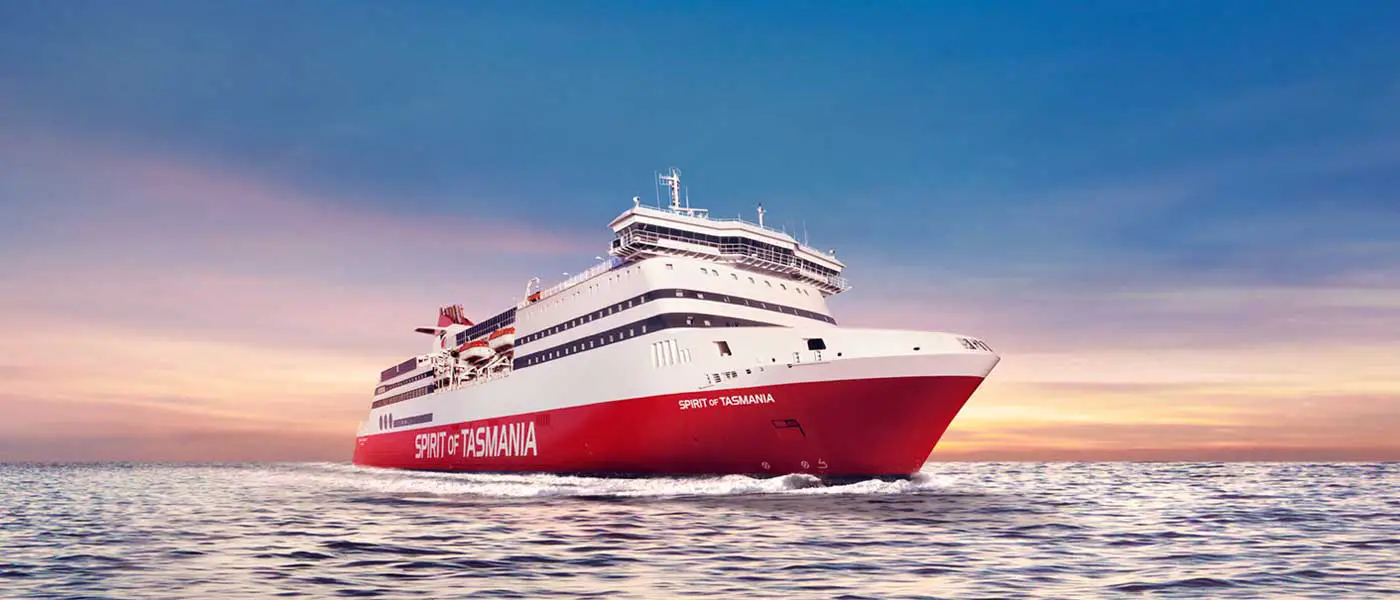
The first car ferry linking Tasmania and the mainland was the Taroona, of 4,286 tons, which arrived in Melbourne in March 1935 to begin the Bass Strait service. By the 1950s an increasing number of tourists were travelling to Tasmania, and many wanted to drive their own cars. The Taroona could only carry a small number, laboriously loaded on board by crane. However, in Europe the ferry business was being revolutionised by the introduction of Roll-on/Roll-off ships, into which cars could be driven directly on and off. The Federal Government agreed to built a number of such vessels to service Tasmania, to be operated by their Australian National Line. The first of these revolutionary new ships was the motor vessel Princess of Tasmania in 1959.
Over the years, two attempts have been made to operate a car and passenger ferry service between Sydney and Tasmania, but with limited success. The first was with the Empress of Australia, which was custom built at Sydney’s Cockatoo Island Dockyards in 1962 for Australian National Line, to provide a ferry serice between Sydney (the terminal was at Morts Bay, Balmain) and Hobart via Devonport and Burnie. Empress of Australia sailed between Sydney and Hobart three times each fortnight. Trade never reached expectations, and in 1972, the vessel was transferred to the Melbourne-Devonport run.
Spirit of Tasmania III was introduced in January 2003, reviving the Sydney to Tasmania service, however it did not visit Hobart, instead docking at Devonport with its two sister vessels. It made the 22 hour journey between Darling Harbour, Sydney, and Devonport three times a week. Like Princess of Tasmania three decade earlier, the Sydney-Tasmania service was initially a success but rising costs, an air fare war and a general slowing down of the tourist trade resulted in the vessel running regularly at below half capacity. This led to the withdrawal of the service in August 2006.
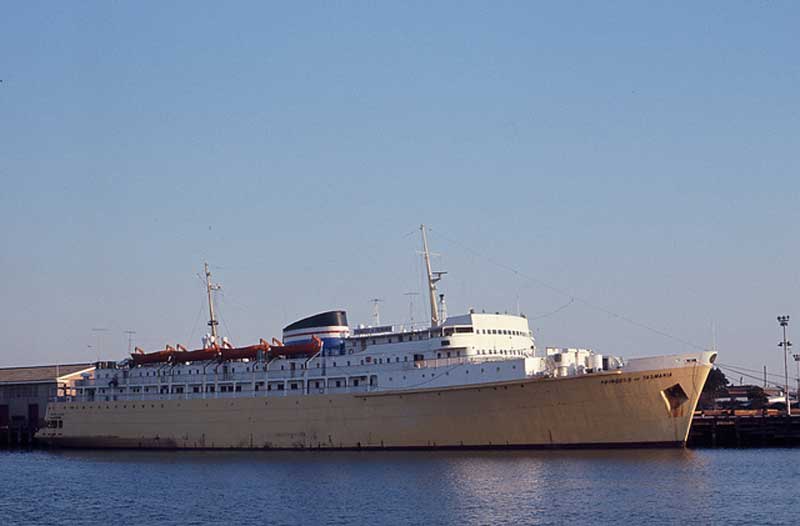
Princess of Tasmania
The Princess, as she was affectionately known, was the pioneer of roll-on/roll-off ferry services in Australia, and played a major role in making Tasmania an attractive, affordable holiday destination for mainlanders. Her story began in 1959, when Australian National Line commissioned the Newcastle-built Princess of Tasmania, then the largest roll-on/roll-off ship in the world, to pioneer what became Australia’s premier car and passenger ferry service, operating between Tasmania and the mainland. The Princess of Tasmania carried 334 passengers, 178 in cabins and 156 in lounge chair type accomodation, and had room for 100 cars. At 4,619 tonnes, she was small in comparison with today’s vessels which have gross tonnage of 29,338 tonnes.
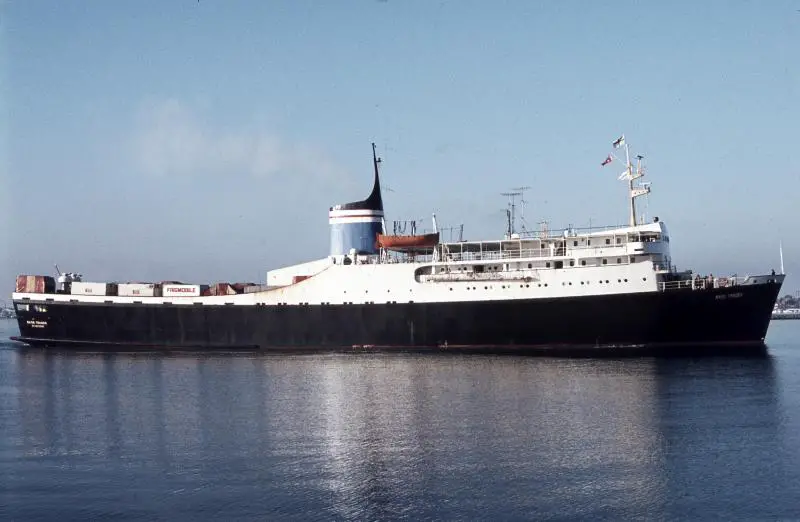
MV Bass Trader. Photo: ShipSpotting.com
The ship crossed Bass Strait between Melbourne and Devonport three times a week each year between 1959 and 1972, except during August and September, when she was laid up for service and maintenance. The Bass Trader, a smaller vessel that only carried heavy vehicles and no passengers, joined her in 1961. The Australian Trader was later sold to the Royal Australian Navy for conversion into the training ship Jervis Bay, leaving just the Empress on the Melbourne to Devonport run.
The drive-on drive-off car ferries Spirit of Tasmania I and II operate between Melbourne and Devonport, sailing from both locations most nights and some days during peak periods. These vessels maintain the proud tradition of one of Australia’s most successful and profitable transport services. In 1975, Princess of Tasmania was sold to Marine Atlantic of Canada and operated as Marine Cruiser until 1984. Subsequent name changes are: Majorca Rose (1984), Equator (1984), Nomi (1984-1985), Adriatic Star (1985-1988), Lampedusa (1988-1991), Shahd Fayez (1991-1993), Al Mahrousa (1993-2000) and Tebah 2000 (2000-2005). Tebah 2000 was scrapped in India in March 2005.
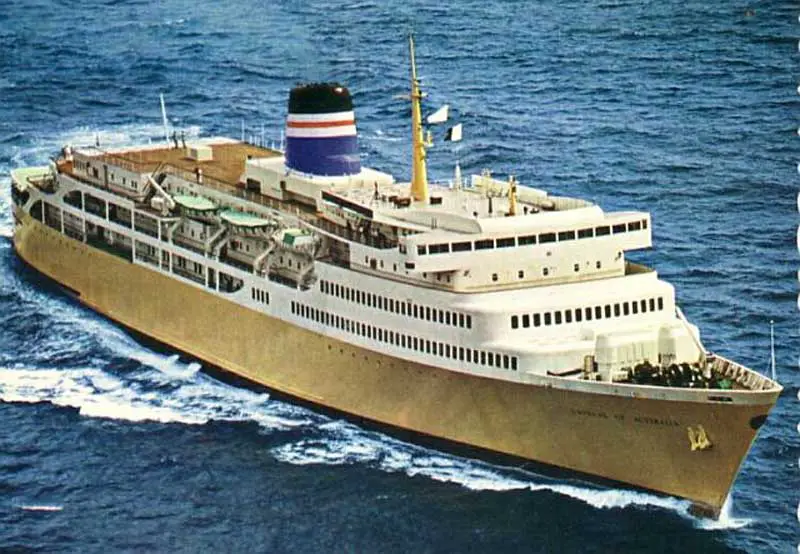
Empress of Australia
Over the years, two attempts have been made to operate a car and passenger ferry service between Sydney and Tasmania, but with limited success. The first was with the Empress of Australia, which was custom built at Sydney’s Cockatoo Island Dockyards in 1962 for Australian National Line, to provide a ferry serice between Sydney (the terminal was at Morts Bay, Balmain) and Hobart via Devonport and Burnie. It had a gross weight of 12,037 tonnes, and was the largest vessel of this type in the world when built while its route was one of the longest open water routes in the world for a vessel of this type. It could carry 250 passengers, 51 cars and 33 semi trailers (or 91 cars and 16 trucks) and travelled at an average speed of 17.5 knots.
Empress of Australia sailed between Sydney and Hobart three times each fortnight. Trade never reached expectations, and in 1972, the vessel was transferred to the Melbourne-Devonport run, replacing the Princess of Tasmania which was sold. The passenger ccapacity was increased to some 450, with the addition of about 200 seats, for the Melbourne-Devonport overnight service. Empress of Australia was sold 1985 after 20 years of service, and renamed Royal Pacific. She sank in the Malacca Strait, in 1991 after colliding with a Taiwanese fishing vessel.
Over the years, two attempts have been made to operate a car and passenger ferry service between Sydney and Tasmania, but with limited success. The first was with the Empress of Australia, which was custom built at Sydney’s Cockatoo Island Dockyards in 1962 for Australian National Line, to provide a ferry serice between Sydney (the terminal was at Morts Bay, Balmain) and Hobart via Devonport and Burnie. Empress of Australia sailed between Sydney and Hobart three times each fortnight. Trade never reached expectations, and in 1972, the vessel was transferred to the Melbourne-Devonport run.
Spirit of Tasmania III was introduced in January 2003, reviving the Sydney to Tasmania service, however it did not visit Hobart, instead docking at Devonport with its two sister vessels. It made the 22 hour journey between Darling Harbour, Sydney, and Devonport three times a week. Like Princess of Tasmania three decade earlier, the Sydney-Tasmania service was initially a success but rising costs, an air fare war and a general slowing down of the tourist trade resulted in the vessel running regularly at below half capacity. This led to the withdrawal of the service in August 2006.

The Princess, as she was affectionately known, was the pioneer of roll-on/roll-off ferry services in Australia, and played a major role in making Tasmania an attractive, affordable holiday destination for mainlanders. Her story began in 1959, when Australian National Line commissioned the Newcastle-built Princess of Tasmania, then the largest roll-on/roll-off ship in the world, to pioneer what became Australia’s premier car and passenger ferry service, operating between Tasmania and the mainland. The Princess of Tasmania carried 334 passengers, 178 in cabins and 156 in lounge chair type accomodation, and had room for 100 cars. At 4,619 tonnes, she was small in comparison with today’s vessels which have gross tonnage of 29,338 tonnes.

MV Bass Trader. Photo: ShipSpotting.com
The ship crossed Bass Strait between Melbourne and Devonport three times a week each year between 1959 and 1972, except during August and September, when she was laid up for service and maintenance. The Bass Trader, a smaller vessel that only carried heavy vehicles and no passengers, joined her in 1961. The Australian Trader was later sold to the Royal Australian Navy for conversion into the training ship Jervis Bay, leaving just the Empress on the Melbourne to Devonport run.
The drive-on drive-off car ferries Spirit of Tasmania I and II operate between Melbourne and Devonport, sailing from both locations most nights and some days during peak periods. These vessels maintain the proud tradition of one of Australia’s most successful and profitable transport services. In 1975, Princess of Tasmania was sold to Marine Atlantic of Canada and operated as Marine Cruiser until 1984. Subsequent name changes are: Majorca Rose (1984), Equator (1984), Nomi (1984-1985), Adriatic Star (1985-1988), Lampedusa (1988-1991), Shahd Fayez (1991-1993), Al Mahrousa (1993-2000) and Tebah 2000 (2000-2005). Tebah 2000 was scrapped in India in March 2005.

Over the years, two attempts have been made to operate a car and passenger ferry service between Sydney and Tasmania, but with limited success. The first was with the Empress of Australia, which was custom built at Sydney’s Cockatoo Island Dockyards in 1962 for Australian National Line, to provide a ferry serice between Sydney (the terminal was at Morts Bay, Balmain) and Hobart via Devonport and Burnie. It had a gross weight of 12,037 tonnes, and was the largest vessel of this type in the world when built while its route was one of the longest open water routes in the world for a vessel of this type. It could carry 250 passengers, 51 cars and 33 semi trailers (or 91 cars and 16 trucks) and travelled at an average speed of 17.5 knots.
Empress of Australia sailed between Sydney and Hobart three times each fortnight. Trade never reached expectations, and in 1972, the vessel was transferred to the Melbourne-Devonport run, replacing the Princess of Tasmania which was sold. The passenger ccapacity was increased to some 450, with the addition of about 200 seats, for the Melbourne-Devonport overnight service. Empress of Australia was sold 1985 after 20 years of service, and renamed Royal Pacific. She sank in the Malacca Strait, in 1991 after colliding with a Taiwanese fishing vessel.
- The Sydney to Hobart Run
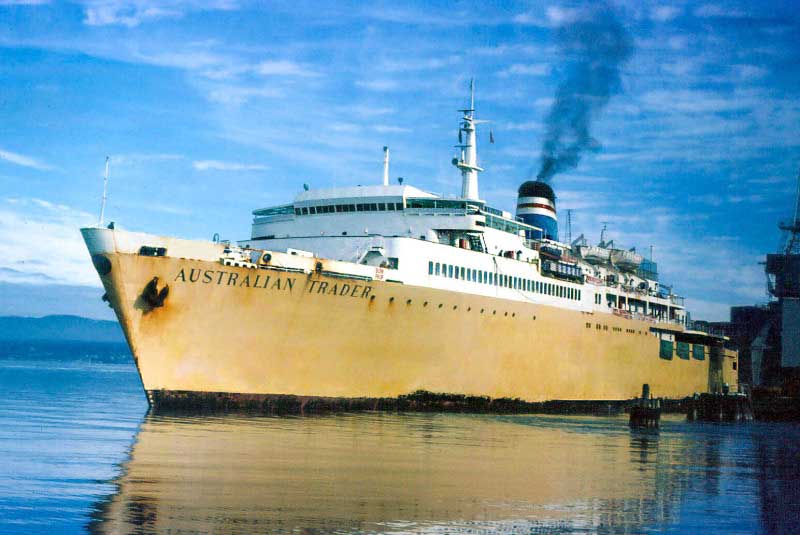
In 1972, the Empress was deployed on the Melbourne-Devonport run and the smaller Australian Trader was transferred from the Melbourne-Devonport run to the Sydney-Hobart run. The return leg was via Bell Bay and Burnie on Tasmania’s north coast. The Australian Trader provided accommodation for 190 passengers and 110 motor vehicles. It soon became clear the Australian Trader had inadequate passenger facilities for the 2-day journey. The vessel has low ceilings, there was no natural light in the dining room or main lounge, the vessel lacked a laundry and a nursery for children, and morning and afternoon tea was only available from a vending machine.
The service the Trader provided was but a shadow of its predecessor. Furthermore, the Trader was dogged by a series of strikes by maritime unions. Passenger numbers fell dramatically along with the ship’s reputation, and it was withdrawn from service in 1976. The Australian Trader was sold in 1985 to the Royal Australian Navy for conversion into the training ship Jervis Bay.
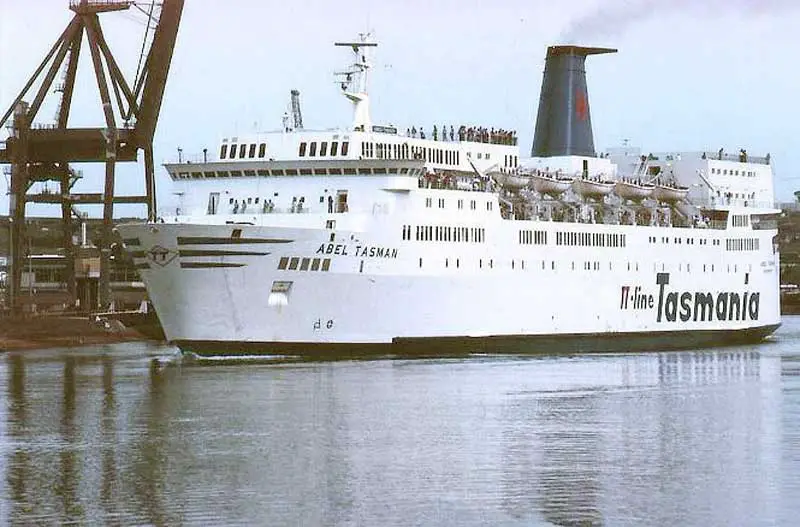
In 1985 the Australian National Line decided to pull out of the Bass Strait ferry service, and the Federal Government, as part of a compensation package for not allowing the Tasmanian Government to build a hydro-electric scheme on the Gordon River, funded the setting up of TT-Line to run the Bass Strait ferry service. TT-Line, which continues to operate the trans-Bass Strait ferries, is owned by the people of Tasmania, being operated by a Board of Management that reports directly to the State Government. The first vessel to be acquired was the former European ferry Nils Holgersson, built in 1975, renamed Abel Tasman. The vessel’s service speed was up to 18 knots and the time taken for the berth to berth distance of 232 nautical miles was generally a little over 14 hours.
Three return Bass Strait crossings per week were made. Facilities included three restaurants, children’s play room and nursery, swimming pool, saunas, shop, medical service, live entertainment in the main lounge, and a mini cinema. Travellers had the choice of 2 and 4 berth cabins, hostel accomodation or deluxe suites. Abel Tasman was 149 metres in length and 23.5 metres in width, has a gross weight of 12,528 tonnes and could carry up to 919 passengers on four accomodation deck levels and 234 cars. Abel Tasman maintained a regular and reliable service until being replaced by the much larger Spirit of Tasmania in 1993. She was sold to a Greek shipping line for work in the Greek Islands. After a number of subsequent changes of owners and names, she still plies the waters of Greece, sailing under the name Ouzoud between Thessaloniki and Limnos, with an occasional stop in Mykonos.
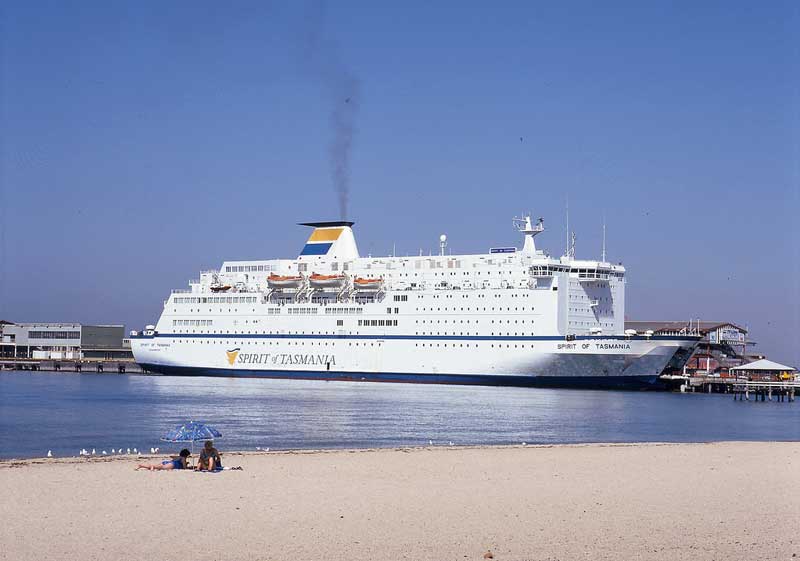
The original Spirit of Tasmania was built in Bremerhaven, West Germany in 1986 as the MV Peter Pan, her first four years were spent on the Travem-Trelleborg route. The first of four sister ships and the first to bear the name Spirit of Tasmania, she was purchased by Tasman’s TT Line from Germany’s TT Line – that they have the same name is sheer coincidence – and arrived in Australian waters to begin her duties on the trans-Bass Stait run at the end of 1993. Spirit of Tasmania had an overall length of 161.52 metres; a gross weight of 31,360 tonnes, a passenger capacity of 1,294, and a vehicle capacity of a maximum of 118 trucks; 550 cars or 300 cars with 40 trailers.
Its public rooms included a bar, cafeteria/coffee shop, buffet and a-la-carte dining rooms, a conference room and a gaming room. She sailed four return trips a week. The crossings were overnight and took approximately 15 hours. The ship was purchased on the basis of having a 10 year usable life, which she completed successfully. In 1992 she was sold to Nordsjferger, refitted and charted to Fjord Line with a new name, Fjord Norway. She was sold again in 2006, renamed MS Princess of Norway, and began sailing on the Newcastle (UK) – Stavanger – Haugesund – Bergen route.
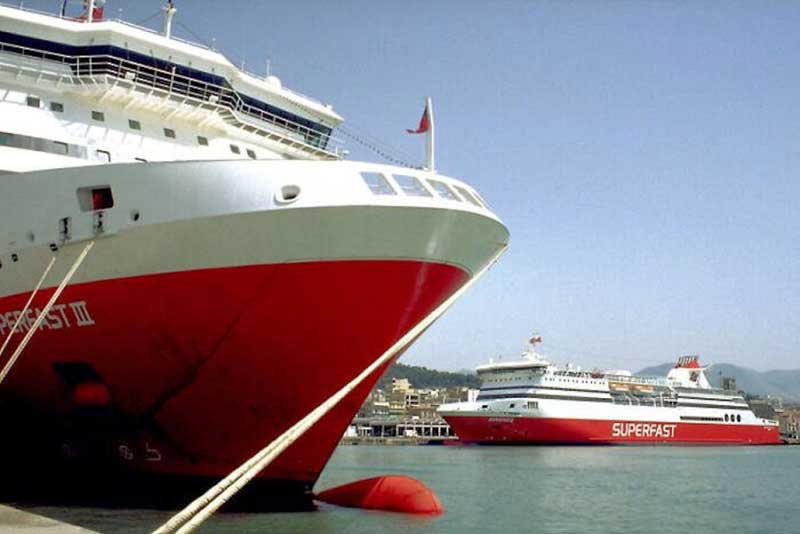
Two similar ferries, Spirit of Tasmania I and II, replaced the first Spirit of Tasmania in September 2002, allowing the operators to provide a service each way each day. Bother vessels are capable of a 10 hour crossing of Bass Strait enabling two return services within 24 hours, using both of them at peak times. The largest car ferries to operate in Australian waters, they offer a variety of accommodation for the 11 hour journey across Bass Strait from fully equipped cabins to sleeper seats. Food (dinner and breakfast) is available from a serve-serve eatery or an a-la-carte restaurant, drinks and light snacks are available from four bars. The vessels also have a gaming room, a children’s playroom, television screens, a cinema screening complimentary movies and a souvenir shop and tourism facility. They each have a carrying capacity of 1,400 passengers, 650 cars and 40 semi-trailers, and upon their introduction, more than doubled the capacity of the Bass Strait passenger trade. The ships have a gross weight of 29,338 tonnes.
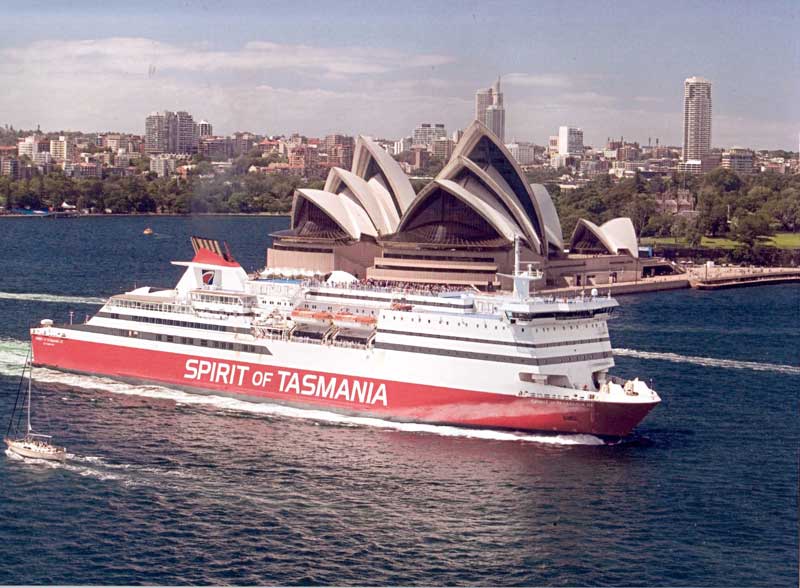
Spirit of Tasmania III was introduced in January 2003, reviving the Sydney to Tasmania service. It made the 22 hour journey between Darling Harbour, Sydney, and Devonport three times a week. The German-built vessel, previously called Superfast II, had been used as a freight, car and passenger ferry between Greece and Italy. Very similar in specifications to Spirit of Tasmania I and II and one of a number of sister ships, she was slightly shorter than Spirit of Tasmania I and II, but had a passenger capacity of 1,400 and space to carry 410 cars. Like Princess of Tasmania three decade earlier, the Sydney-Tasmania service was initially a success but rising costs, an air fare war and a general slowing down of the tourist trade resulted in the vessel running regularly at below half capacity. This led to the withdrawal of the service in August 2006. Spirit of Tasmania III was sold to Mediterranean operator Corsica Ferries even before it had completed the 2005/06 season. The ship left on its final voyage on 27th August 2006 and has been renamed Mega Express Four.
The morning cruise up the coast of New South Wales to Sydney on Spirit of Tasmania 3 was, for me, one of the most enjoyable and relaxing journeys I have ever undertaken in Australia; it gave travellers a unique and inexpensive opportunity to sail along Australia’s coastline and it is a tragedy that we have lost one of the great Australian journeys.
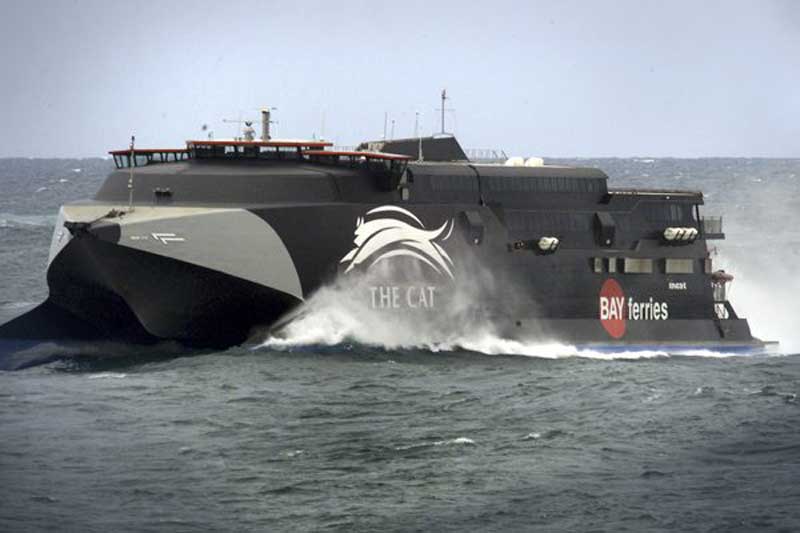
A fast Bass Strait crossing service between Melbourne and George Town was offered for one season with the Tasmanian-built car-carrying catamaran, Devil Cat. Inspired by the tenacity of the native Tasmanian Devil, the dual-hull vessel INCAT 046 was designed and built by Incat in Hobart and holds the Trans-Atlantic speed record for passenger ships. It replaced an earlier Devil Cat catamaran, Incat 023 which introduced the service in 1990. Launched in 1997, INCAT 046 is 96 metres long, weighs 800 tonnes, travels at 70 km/h (44 mph) fully loaded and carries 600 people plus cars and trucks. The vessel operated between Port Welshpool (Vic) and George Town (Tas) in conjunction with the original Spirit of Tasmania. Weather conditions in the Bass Strait occasionally led to cancellation during storms and heavy seas. The vessel’s ride on during choppy conditions on the 6-hour crossing led to its nickname “Spew Cat” and it was retired from the route after a single season.
INCAT 046 was sold to Bay Ferries in 1998 for service on that company’s Gulf of Maine route between Yarmouth, Nova Scotia and Bar Harbour, Maine under the name, The Cat. The vessel departed Hobart on 26th April 1998, arriving in Yarmouth to great fanfare from American and Canadian news media. The vessel was re-sold in 2002 to Incat as a trade-in, then leased by the Interisland Line, a New Zealand company, for which it was used in Cook Strait that year, under the name, The Lynx. Bay Ferries subsequently repurchased the vessel and uses it on a route in Trinidad and Tobago between Port of Spain and Scarborough, maintaining the name The Lynx. As of 2006, HSC INCAT 046 was still operating this route in the Caribbean Sea for Bay Ferries, under a wet charter for the Government of Trinidad and Tobago.
